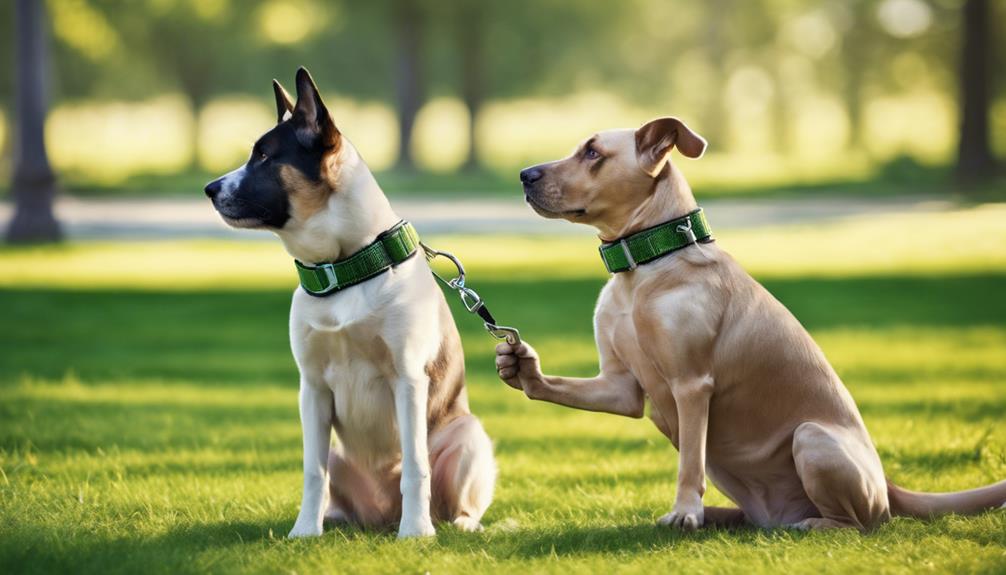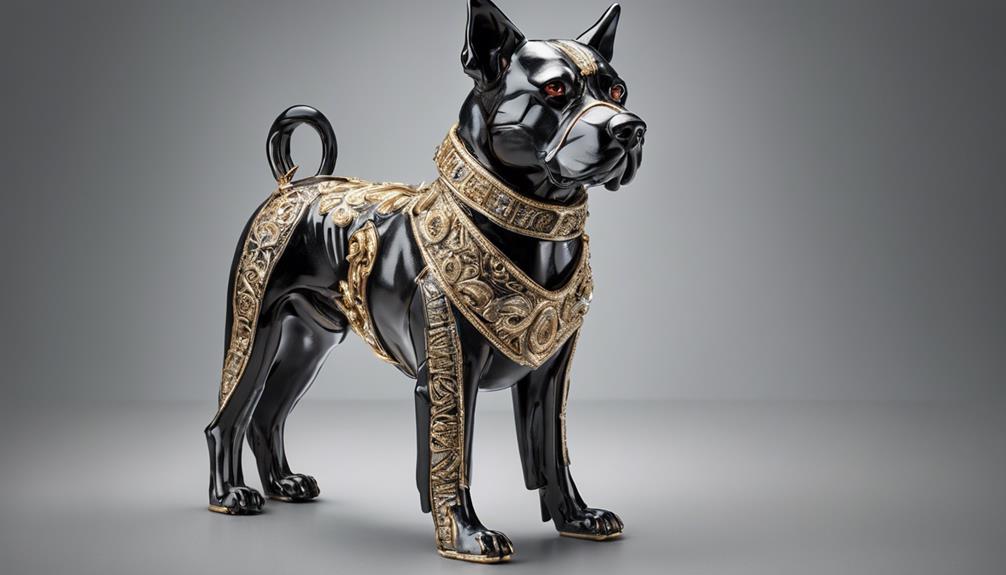When learning how to train your dog using a shock collar, it is important to have a solid grasp of the fundamentals and techniques in order to effectively communicate with our beloved furry friends. Ensuring that the collar fits snugly and is positioned correctly on our dog’s neck is crucial. It is essential to begin at the lowest stimulation level and make adjustments gradually to avoid any discomfort. Seeking advice from a professional trainer and combining verbal commands with collar stimulation is recommended. Prioritizing safety and effectiveness is key to guaranteeing a positive training outcome.
Remember, there's always more to discover in achieving successful shock collar training results.
Key Takeaways
- Properly fit and position the shock collar on your dog's neck for consistent and reliable stimulation.
- Start training at the lowest stimulation level and adjust gradually to avoid discomfort.
- Seek guidance from a professional trainer to ensure correct usage and effective training techniques.
- Combine collar stimulation with verbal commands for better communication and behavior shaping.
- Monitor progress, adjust stimulation levels accordingly, and use positive reinforcement techniques for successful training outcomes.
Understanding Shock Collar Basics
Understanding the basics of shock collar training is important for effectively communicating with and training your dog.
When it comes to dog training, the shock collar can be a valuable tool if used correctly. It's vital to view the stimulation provided by the shock collar as a means to get your dog's attention rather than a form of punishment.
Think of it as a gentle tap on the shoulder to redirect your dog's focus. This perspective is fundamental in incorporating positive reinforcement techniques into your training regimen.
Proper Fit and Placement

To ensure successful communication and reliable stimulation, it's essential to correctly fit and position the shock collar on your dog's neck. Proper fit and placement of the collar are pivotal for ensuring effective training outcomes.
The shock collar should have snug contact points on the dog's neck to maintain consistent skin contact for dependable stimulation. Ensuring the correct placement of the collar sensors is crucial as it helps in delivering precise and controlled stimulation during training sessions.
A snug fit not only aids in reliable stimulation but also contributes to safe and humane training practices. By securing the collar properly on your dog, you can enhance the communication between you and your pet, leading to more efficient training results.
Paying attention to the proper fit and placement of the shock collar demonstrates your commitment to your dog's well-being and the effectiveness of the training process. Remember, a well-fitted collar is a key element in mastering the use of a shock collar for training purposes.
Setting Stimulation Levels Correctly
Setting the stimulation levels correctly plays an important role in guaranteeing effective and comfortable training for your dog.
To begin, it's recommended to start at the lowest stimulation level possible to assess your dog's sensitivity threshold. Pay close attention to how your dog responds to the initial stimulation, and adjust the level gradually based on their reactions.
It's vital to avoid using high levels of stimulation unnecessarily, as this can lead to discomfort or stress for your dog. Seeking guidance from a professional trainer is advisable to make sure that the stimulation levels are set correctly according to your dog's specific training requirements.
Regularly monitoring and reassessing the stimulation levels is key to maintaining effectiveness and ensuring your dog's comfort throughout the training process. Remember, the goal is to create a positive and successful training experience for your furry companion.
Training Techniques and Commands

When training your dog with a shock collar, integrating a combination of techniques and commands is essential for effective communication and behavior shaping. Here are some key techniques and commands to contemplate:
- Professional Dog Trainer: Ponder seeking guidance from a professional dog trainer who can provide personalized advice on how to use the shock collar effectively and humanely.
- Leash Freedom: Utilize the collar in conjunction with leash training to gradually introduce your dog to off-leash freedom while still maintaining control and safety.
- Collar Stimulation: Employ collar stimulation in combination with verbal commands to teach your dog desired behaviors such as sit, down, and recall effectively.
Ensuring Safety and Effectiveness
Ensuring the safety and effectiveness of shock collar training requires careful attention to proper fitting and desensitization techniques for creating a comfortable learning environment for your dog. Proper fitting of the shock collar ensures consistent contact with your dog's skin, optimizing the training experience. Desensitizing your dog to the collar through positive associations is key to building trust and reducing stress. Additionally, finding the right stimulation level gradually and using positive reinforcement alongside shock collar training is vital for your dog's well-being. A professional dog trainer can assist in determining the correct settings and techniques for your specific training goals. Regular monitoring and adjustment of stimulation levels based on progress and distractions further enhance the safety and effectiveness of the training.
| Safety Tips | Effectiveness Tips |
|---|---|
| Proper fitting of the collar | Desensitization through positive associations |
| Gradually find right stimulation level | Utilize positive reinforcement techniques |
| Seek guidance from a professional trainer | Monitor and adjust based on progress |
| Regularly monitor and adjust stimulation levels |
Frequently Asked Questions
What Is the Best Way to Train a Dog With a Shock Collar?
We believe the best way to train a dog with a shock collar is to gradually find the right stimulation level, focus on basic commands, reinforce with proper timing, and use positive reinforcement. This approach guarantees effective communication and a positive training experience.
Do Professional Dog Trainers Use Shock Collars?
Professional dog trainers vary in their methods; however, many do not use shock collars. We prioritize positive reinforcement and force-free techniques. Our dedication to ethical and effective training guarantees the well-being and behavioral success of our canine companions.
What Not to Do With a Shock Collar?
When using a shock collar, it's important not to employ it as punishment, lack proper training, use high levels unnecessarily, target sensitive areas, or rely solely on it. Positive reinforcement should always complement shock collar training.
What Do Veterinarians Say About Shock Collars?
Veterinarians warn against using shock collars due to risks like increased stress, fear, and aggression in dogs. They advocate for positive reinforcement training methods over aversive techniques. Prioritize your dog's well-being and seek alternative training approaches.
Are Shock Collars an Effective Training Tool for Dogs?
Shock collars have been debated as a method for mastering dog training techniques, but their effectiveness is contentious. While some trainers believe they can be useful in certain situations, others argue that positive reinforcement and consistency are better approaches for effective dog training.
What are the best shock collar training techniques for various popular animals?
Shock collar training techniques can be effective for various popular animals. However, it’s important to use these tools carefully and with knowledge of the specific animal’s behaviors. Consult with a professional animal trainer before implementing shock collar training. In the meantime, enjoy these fascinating animal facts about your favorite creatures!
Can I Use the Techniques from Remote Dog Training Collars to Master Shock Collar Training for My Dog?
Yes, you can use the techniques from remote dog training collars to master shock collar training for your dog. By following the remote dog training collars suggestions, you can effectively train your dog using a shock collar with positive reinforcement and consistent commands.
Conclusion
To wrap up, mastering dog shock collar training takes time, patience, and consistency. Just like acquiring any new skill, it requires dedication and effort.
Remember, the shock collar is a tool to aid in training, not a punishment device. By following the proper techniques and commands, you can guarantee the safety and effectiveness of using a shock collar.
Trust the process, and soon you'll see the results you've been working towards.
Happy training!










